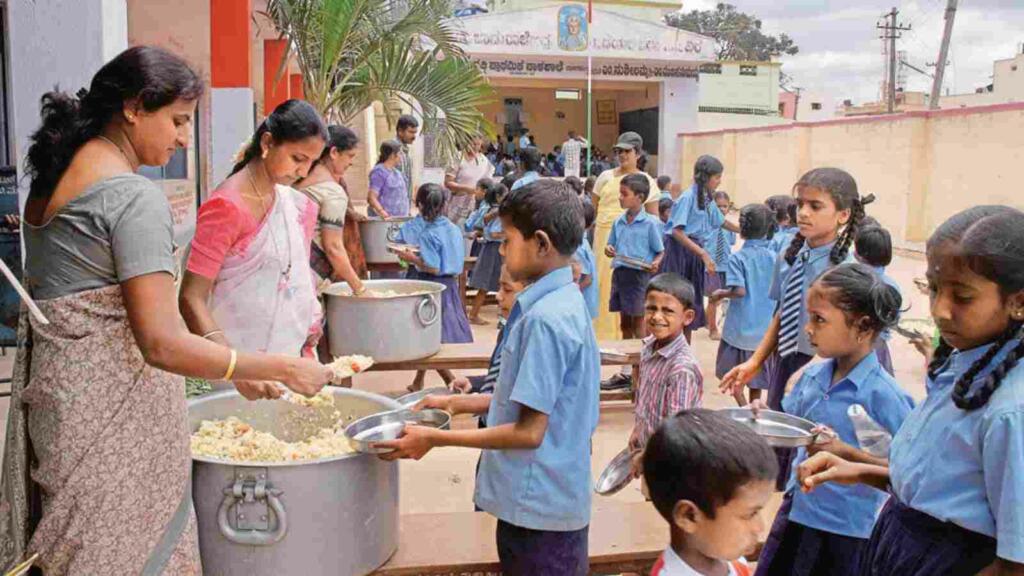The Midday Meal Program was launched in 1995 to provide free cooked meals with a minimum energy of 450 kcal to school.
About MDM and Importance of Mid Day Meal Programme (Mid-day Meal Scheme).
The Cabinet committee on economic affairs (CCEA) approved the PM POSHAN (POshan SHAkti Nirman) scheme to provide a hot cooked meal in government and government-assisted schools from 2021-22 to 2025-26, formerly known as the ‘National School Lunch Program’ popularly known as a noon meal plan. It is a centrally sponsored plan that covers all school-age children studying in classes I through VIII in government schools with government assistance.
The scheme covers around 11.80 crore children studying in 11.20 lakh schools across the country. During 2020-21, the Indian government invested more than Rs 24,400 crore in the scheme, including the cost of around Rs 11,400 crore in food grains. In this article we are going to descussing about details, objectives, features, overview and Importance of Mid Day Meal Programme.
The Cabinet Committee on Economic Affairs (CCEA), chaired by the Honorable Prime Minister, has approved the continuation of the national PM POSHAN scheme in schools for the five-year period 2021-22 to 2025-26 with the financial outlay of ₹ Rs 54061.73 crore from central government and ₹ 31,733.17 crore from state governments and UT administrations. The central government will also bear an additional cost of approximately Rs 45 billion in food grains. Therefore, the total budget of the plan will amount to Rs 130,794.90 crore.
Also Read : Rinku Kumari: Her efforts to make her village ODF and Swatchhagrahi awardee
The objectives of the MDM scheme are
Importance and objectives of Mid Day Meal Programme
-Increase enrollment in schools for children belonging to disadvantaged sectors of society.
-Increase children’s attendance in government and government-subsidized schools.
-Retain children studying in classes I to VIII.
-Provide nutritional support to children studying in the primary stage, especially in areas affected by drought.
-Address hunger and malnutrition and improve inter-caste socialization.
Importance of Mid Day Meal Programme
The program will replace the existing national school midday meal plan or midday meal plan, known as PM POSHAN with the center initiating a major policy push focused on infant nutrition and announcing that about 24 crore students in the public preschool education will also be enrolled in government – subsidized schools according to the scheme. PM Poshan’s new members are expanding the program for kindergarten students or Bal Vatikas.
The MDM program provides meals to all children enrolled in public schools, local government schools, government-funded schools, Specialized Training Centers (STCs), maktabs and madrassas that are supported by Sarva Shiksha Abhiyan.
Also Read : Say No to Plastic Bags : No to plastic equals to Yes to healthy life
Features, benefits and Importance of Mid Day Meal Programme
Key points of Features, benefits and Importance of Mid Day Meal Programme are here.
1. MDM Rules: The notification regarding implementation of new rules and regulations regarding the scheme can be identified from the website, it includes recent amendments made in the rules and following of guidelines. Other features include Union Budgetary Allocation, Central Assistance, Food grain allocation, workshops etc.
2. Monitoring of MDMS: The scheme monitoring held by desk monitoring and field monitoring which includes statistics theoretically inspected by field monitors by research and analysis by forming various committees.
3. WASH in Schools (Water, sanitation and hygiene in schools): report of the South Asia Regional Conference on WASH in schools, “WASH in schools: making it happen”. This conference was jointly organized by the Ministry of Drinking Water and Sanitation, Government of India, Ministry of Human Resource Development, Government of India and UNICEF. Its implementation has already been a success in Assam and other states are yet to implement the programme.
4. Meal Provision: Since its initiation, the scheme has been revised from time to time and the present provisions are as given below: –
Free supply of food grains at 100 grams per child per school day at Primary and 150 grams per child per school day at Upper Primary.
Subsidy for transportation of food grains is provided to 11 special category states at PDS rate prevalent in these states and up to a maximum of Rs.75.00 per quintal for other than special categories States/UTs
Also Read : Rastriya Swachhta Diwas : commencement, Significance and progress
In addition to food grains, a mid day meal involves major input, viz., cost of cooking, which is explained below:
Cost of cooking includes cost of ingredients, e.g. pulses, vegetables, cooking oil and condiments as given below
S.No. 1 Items
- Food grains Primary
- 100 gms Quantity per day/ Child
- Upper Primary
- 150 gms
- 2 Pulses 20 gms 30 gms
- 3 Vegetables (leafy also) 50 gms 75 gms
- 4 Oil & fat 5 gms 7.5 gms
- 5 Salt & condiments As per need
5. Research and evaluation: MDM offer excellent opportunities in Education for Sustainable Development (ESD). In keeping with the principles of ESD and the provisions of the RTE Act of 2009, the Resource Book developed by NCERT on ESD titled ‘Towards A Green School’ suggests how MDM can help achieve curricular goals in addition to ensuring wellness of children without putting an additional burden on teachers or students.
Role of State governments in Mid-day Scheme
The state governments are bound to follow the guidelines and rules passed by the center time to time and the implementation and progress achieved by the State governments can be ascertained in the official website under State websites/Useful links. Under the Programme Approval Board (PAB) Meetings section any person can examine and analyze any state’s programmes and schemes by clicking in the appropriate financial year. Here’s the official website link for your convenience.
For more highlights and Importance of Mid Day Meal Programme of the scheme can be read here
Also Read : I Rakhwali App: Application launch and its Reliability
